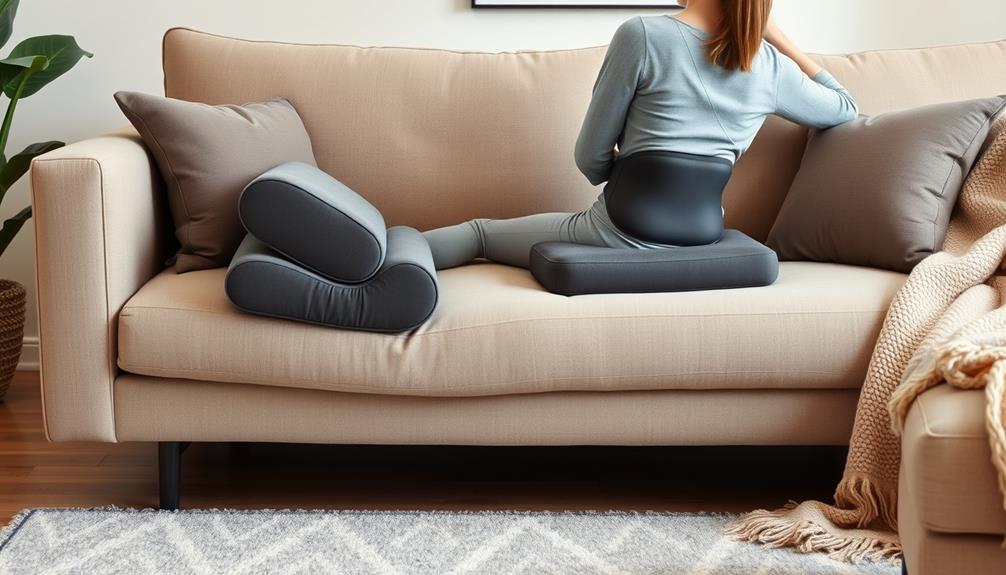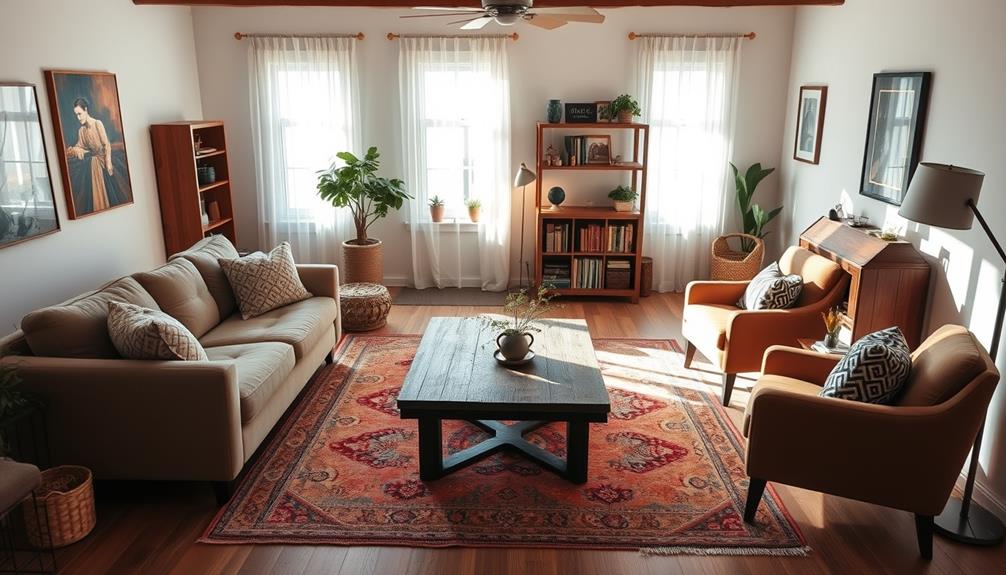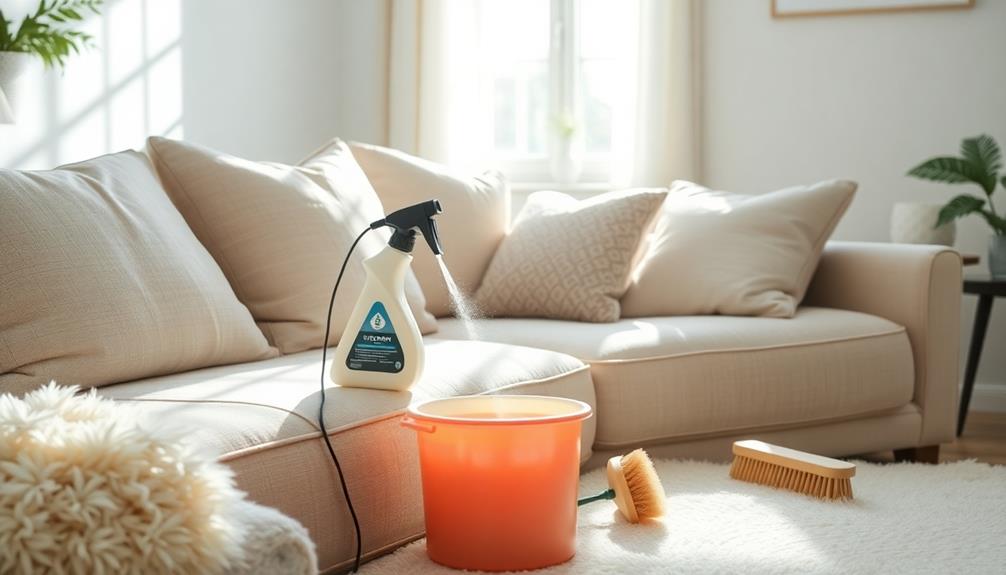To alleviate lower back pain while sitting on a sofa, it is important to maintain good posture. Make sure to keep your feet flat on the floor, knees at a 90-degree angle, and ensure your back is well-supported. Use cushions for lumbar support and avoid slouching. If your sofa is too low, consider raising it or using an extra pillow. Remember to change positions regularly and take movement breaks every 30-60 minutes to prevent stiffness. Incorporating gentle stretches can also help ease discomfort. Interested in learning more ways to improve your sitting experience? Take a look at resources on how to lift heavy furniture properly or consider seeking professional help if you need help rearranging your seating area. Having a sofa at the right height is crucial to prevent additional strain on your lower back. By following these tips, you can create a more supportive and ergonomic sitting space that promotes better back health and overall comfort.
Key Takeaways
- Maintain proper posture by keeping feet flat on the floor and knees at a 90-degree angle to reduce strain on your back.
- Use cushions for lumbar support to preserve the spine's natural curve and prevent slouching while sitting on the sofa.
- Adjust sofa height to ensure knees are level with or slightly lower than hips, promoting spinal alignment and comfort.
- Take regular breaks to stand, stretch, and move every 30-60 minutes to alleviate muscle tension and stiffness.
- Avoid crossing legs to minimize pressure on the lower back, and consider using a lumbar support pillow for additional comfort.
Understanding Lower Back Pain
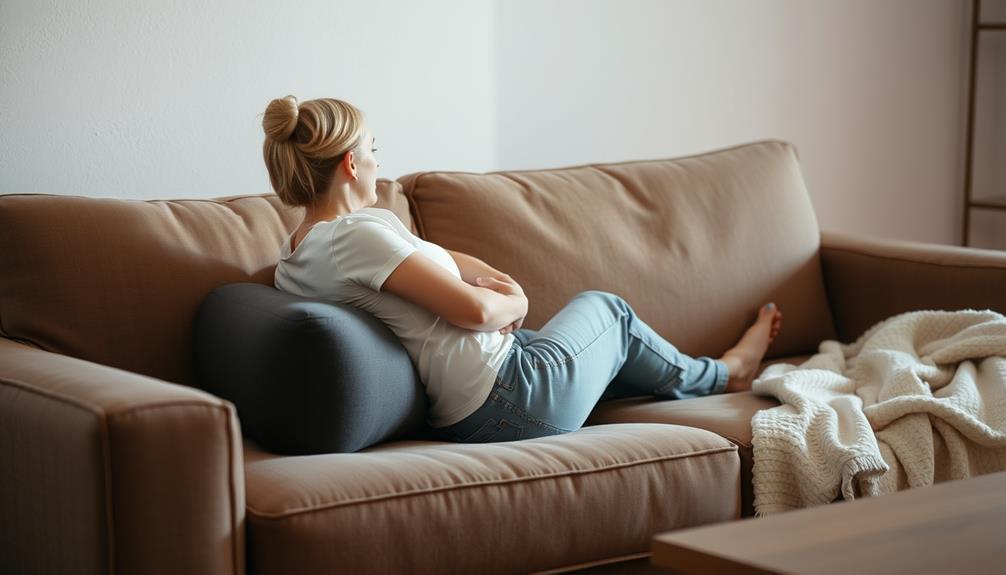
Lower back pain is a common issue that many people face, often stemming from poor sitting habits. When you slouch or sit for prolonged periods without proper back support, you place excessive strain on your spine and surrounding muscles. This can lead to discomfort and even potential injury over time.
Additionally, factors such as weight management and overall physical health can play a role in the severity of back pain; for example, the benefits of maintaining a healthy weight can help alleviate pressure on your back.
Poor posture alters your spinal alignment, increasing pressure on intervertebral discs, which can exacerbate lower back pain. If you're sitting on unsupportive furniture, it may contribute to muscle imbalances and weaken your core stability—both vital for maintaining a healthy back.
Without adequate lumbar support, your spine bears more weight than it should, relying on passive loading instead of engaging the muscles that should be doing the work.
It's essential to be aware of your sitting habits. Aim to maintain a neutral spine and consider using supportive cushions to help alleviate pressure on your lower back.
Importance of Proper Posture
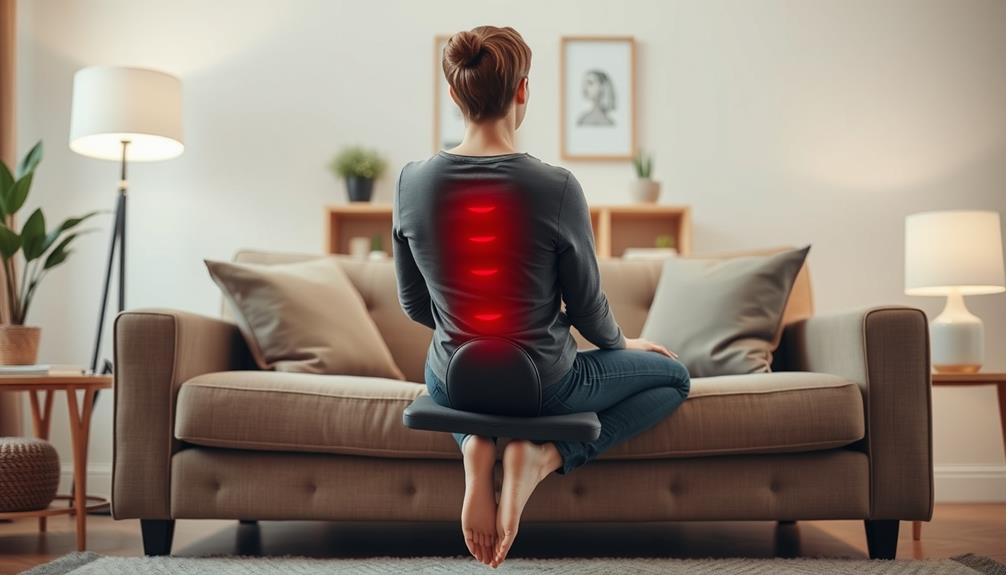
Proper posture is essential for maintaining spinal health, especially when sitting on a sofa for extended periods. By aligning your spine correctly, you can reduce strain on your back muscles and minimize discomfort associated with lower back pain.
To achieve proper posture, make sure your feet are flat on the floor and your knees are at a 90-degree angle. This position promotes ideal lower body support, which is critical for spinal health. Additionally, consider incorporating ergonomic furniture into your home, which can enhance comfort and support your posture over time, similar to how choosing the right vacuum for dust removal can improve your living space.
Utilizing cushions to support your lower back can help preserve the natural curve of your spine, preventing slouching and excessive pressure on lumbar discs. Regularly adjusting your seating position and incorporating movement can also alleviate stiffness and improve blood circulation, both essential for back health during prolonged sitting.
Don't forget to engage your core muscles while sitting. This provides additional support to your spine, enhancing your posture and further reducing the likelihood of lower back pain.
Ideal Sitting Position

To sit comfortably on your sofa and minimize lower back pain, start by placing your feet flat on the floor. You can also use a small pillow or cushion to support your lower back and maintain good posture while sitting. It’s important to take regular breaks from sitting and stretch your lower back muscles to prevent stiffness and discomfort. Additionally, implementing ink stain removal tips, such as using rubbing alcohol or an ink stain remover, can help keep your sofa clean and comfortable for long periods of sitting. Moreover, to enhance the longevity of your sofa, consider addressing any damage promptly. For instance, if you have pets, you may need techniques for repairing cat scratches on sofas to maintain their appearance and comfort. Regularly cleaning and maintaining your sofa can also prevent build-up of dirt and allergens, creating a more pleasant environment for relaxation.
Incorporating gentle stretching before sitting can also help relax your muscles and prepare your body for a more comfortable position, as suggested in simple tips for better sleep.
Make sure your back is fully supported to maintain the natural curve of your spine.
This proper foot placement and back support are essential for preventing strain and promoting good posture.
Proper Foot Placement
When you settle onto your sofa, ensuring your feet are flat on the floor is essential for maintaining ideal alignment. Proper foot placement helps distribute your weight evenly, reducing strain on your lower back. Aim for your knees to be at a 90-degree angle and level with your hips. This minimizes asymmetric pressure that can lead to discomfort.
If your sofa is too low, consider using cushions to elevate your seating position. Avoid crossing your legs, as this creates imbalances and adds pressure on your lower back. Regularly check your foot placement and posture to maintain a good posture, which can greatly alleviate lower back pain.
| Foot Positioning Tips | Benefits |
|---|---|
| Keep feet flat on the floor | Distributes weight evenly |
| Maintain 90-degree knees | Reduces asymmetric pressure |
| Avoid leg crossing | Prevents lower back strain |
| Use cushions if necessary | Aligns knees with hips |
Back Support Essentials
Finding the right back support while sitting on your sofa can make a significant difference in how you feel throughout the day. To guarantee you have the back support essentials in place, start by checking your foot position. Keep your feet flat on the floor to maintain proper alignment and reduce strain on your lower back. Additionally, consider maintaining a comfortable temperature in your space, as extreme conditions can affect your overall comfort and posture, akin to how energy-efficient models can optimize home environments.
Next, make certain your back is fully supported by the sofa or cushions. This helps your spine maintain its natural curve and prevents slouching, which can lead to discomfort. Position your hips level with your knees to avoid putting undue pressure on your spine and hips, a common culprit in exacerbating lower back pain.
Don't forget to incorporate movement breaks! Standing up and stretching regularly helps combat stiffness and discomfort that can arise from prolonged sitting.
If you still need extra support, consider using additional cushions or lumbar support. These can reinforce the natural curvature of your spine, providing added comfort and further reducing the risk of pain.
Tips for Sofa Comfort
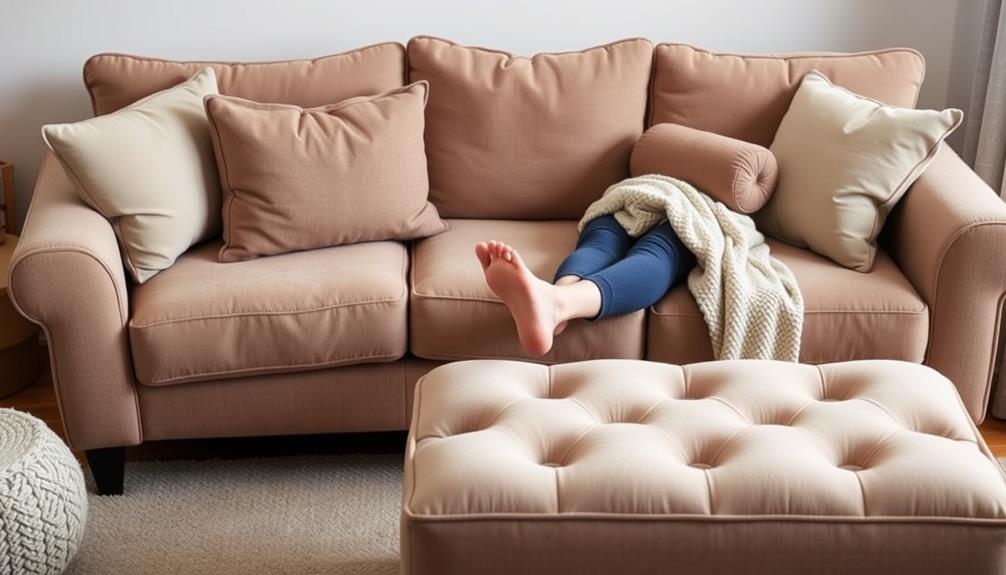
To enhance your comfort on the sofa, proper cushion support is essential. Ensuring that your cushions offer adequate lumbar support can greatly alleviate discomfort and help maintain your spine's natural curve.
Consider the importance of financial planning for assisted living as you assess your long-term needs. Additionally, adjusting your sofa height can keep your feet flat on the floor, promoting better alignment and reducing strain on your back.
Proper Cushion Support
Choosing the right cushions for your sofa is essential for alleviating lower back pain. Firm cushions provide the cushion support you need to maintain proper posture and prevent slouching. Overly soft cushions may feel comfortable initially, but they can lead to poor posture and increased pain over time.
Consider using high-quality materials that offer both comfort and durability, as this can contribute to a better seating experience while you relax on your sofa. Additionally, using well-draining soil for your houseplants can create a more calming environment, making your relaxation time even more enjoyable.
Consider adding a lumbar support pillow behind your lower back. This helps maintain the natural curve of your spine and reduces pressure on your spinal discs. If your knees are higher than your hips while seated, you might want to adjust the height of your sofa seating. Using additional cushions or blocks can promote proper alignment and comfort.
Make sure the cushions you use don't restrict your legs; keeping your feet flat on the floor enhances stability and circulation. It's also a good idea to regularly change the arrangement of your cushions. Experiment with different setups to find the most comfortable configuration that supports your back while allowing for movement and flexibility.
With the right cushion support, you can enjoy your sofa without the burden of lower back pain.
Sofa Height Adjustment
Sofa height plays a crucial role in your overall comfort and spinal health. To achieve the right sofa height adjustment, make certain your knees are level with or slightly lower than your hips. This positioning promotes better spinal alignment and reduces lower back strain.
Additionally, maintaining a proper posture while sitting can help prevent issues like overspending on health costs that arise from discomfort and chronic pain.
When selecting cushions for height adjustment, choose firm options that provide stability and prevent sinking, which can lead to slouched sitting positions. After adjusting, confirm your feet remain flat on the floor; this helps distribute weight evenly and supports proper posture throughout your time on the sofa.
If you find your sofa is too low, consider using risers or switching to a more supportive seating option to achieve a comfortable, ergonomically favorable position.
It's crucial to regularly reassess the sofa height and your comfort level, especially if you notice changes in your body or sitting habits. Doing so will guarantee continued support for your lower back, allowing you to enjoy your sofa without discomfort.
Recommended Sofa Features
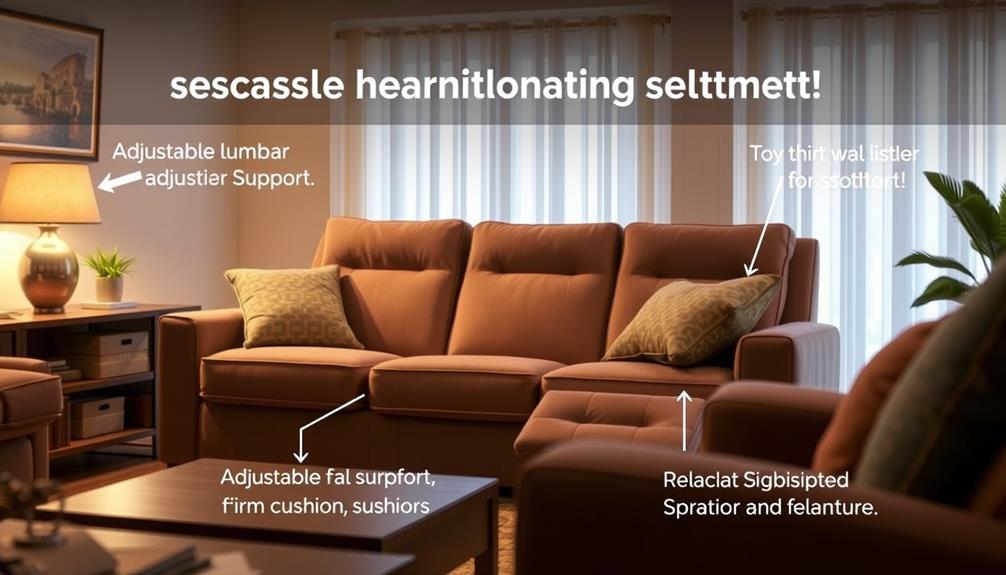
A well-designed sofa can greatly improve your sitting experience, especially if you're dealing with lower back pain. Choosing the right features is vital for providing the necessary support and promoting good posture.
A sofa that provides adequate lumbar support can greatly enhance your comfort, and it's worth noting that the impact of clean fuel injectors on fuel efficiency and emissions is a great analogy for how proper support can optimize your sitting experience.
Here are three recommended sofa features to take into account:
- Strong Frame: Opt for a sofa made from hardwood or solid steel. This guarantees durability and support, helping maintain proper posture while you sit.
- High-Density Cushions: Select high-density cushions that offer firm support without sinking. This is important for keeping your spine aligned and reducing strain on your lower back.
- Adjustable Features: Look for sofas with adjustable components like reclining options or lumbar support. These features enhance ergonomics and allow you to personalize your comfort.
Additionally, make sure the sofa's seat depth and height are suitable for your body type.
A well-fitted sofa will support your weight without sagging over time, further promoting proper posture and minimizing back pain. Investing in these features will make a considerable difference in your comfort and well-being while sitting.
Stretching and Movement
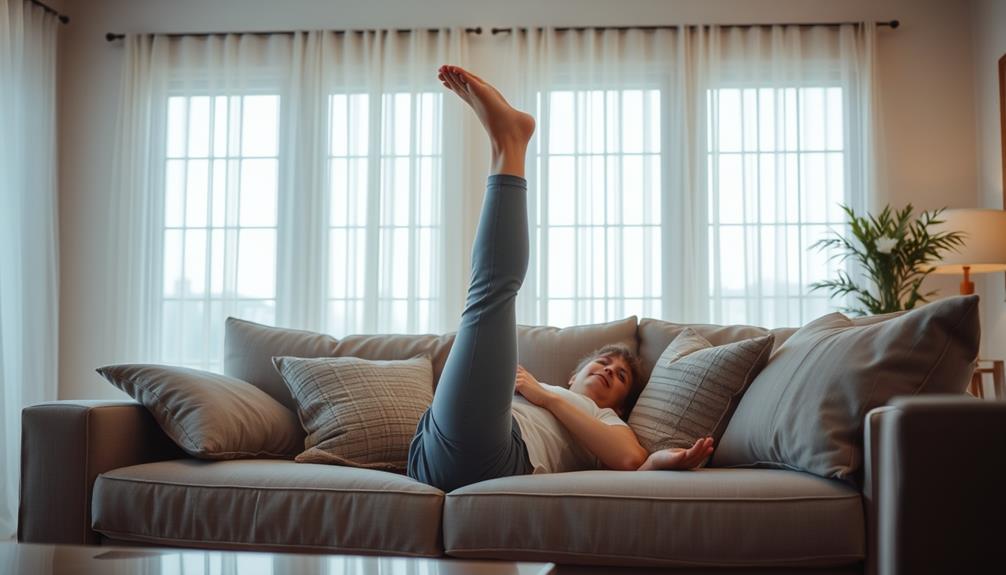
To ease lower back pain while lounging on the sofa, it's essential to incorporate stretching and movement into your routine. Regular stretching exercises, like gentle spinal twists and hip flexor stretches, can alleviate tightness in your lower back and promote flexibility.
While seated, try movements like ankle rolls and leg extensions to enhance circulation and reduce stiffness in your lower body. Additionally, it's important to protect your savings and avoid scams by researching any wellness or fitness programs you might consider, as protecting your savings is vital when investing in your health.
Don't forget to stand up and walk around every 30-60 minutes to break those periods of prolonged sitting, which can contribute to discomfort. Practicing seated stretches—such as reaching toward your toes or doing side bends—can provide immediate relief from lower back tension.
Additionally, engaging in simple core-strengthening exercises, like seated marches or pelvic tilts, helps improve overall back support. These exercises not only enhance stability but also reduce discomfort during those extended sofa sessions.
Self-Assessment Techniques
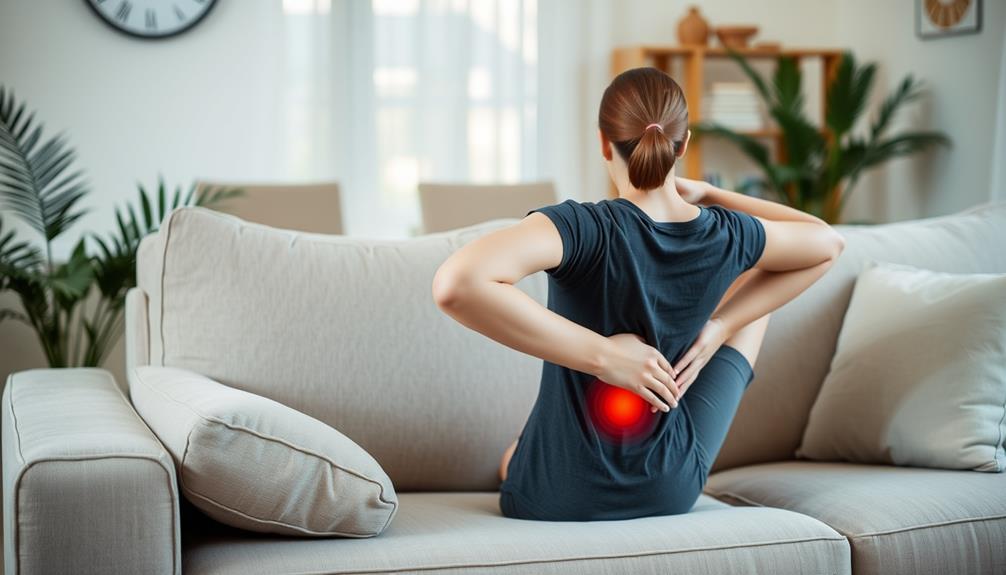
Your body's alignment plays an essential role in managing lower back pain while sitting on the sofa. Regular self-assessment of your posture can help identify misalignments that contribute to back problems.
Incorporating elements of effective consultation techniques into your self-checks can enhance your awareness of posture. Here are three techniques to enhance your self-checks:
- Video Analysis: Record yourself sitting on the sofa and review the footage. This visual feedback allows you to spot poor posture and areas for improvement.
- Comparison with Models: Use standard postural models as a reference. By comparing your sitting posture with these models, you can identify deviations that may need correction.
- X-ray Evaluation: If you're experiencing persistent pain, consider getting an X-ray. It can reveal specific postural issues in your spine that might be exacerbating your lower back pain while sitting.
Maintaining awareness of your body's alignment throughout the day is vital. Regular self-assessment can help you catch any poor posture early, preventing discomfort and encouraging healthier sitting habits.
With consistent practice, you'll be better equipped to manage lower back pain effectively.
Managing Sciatica Symptoms
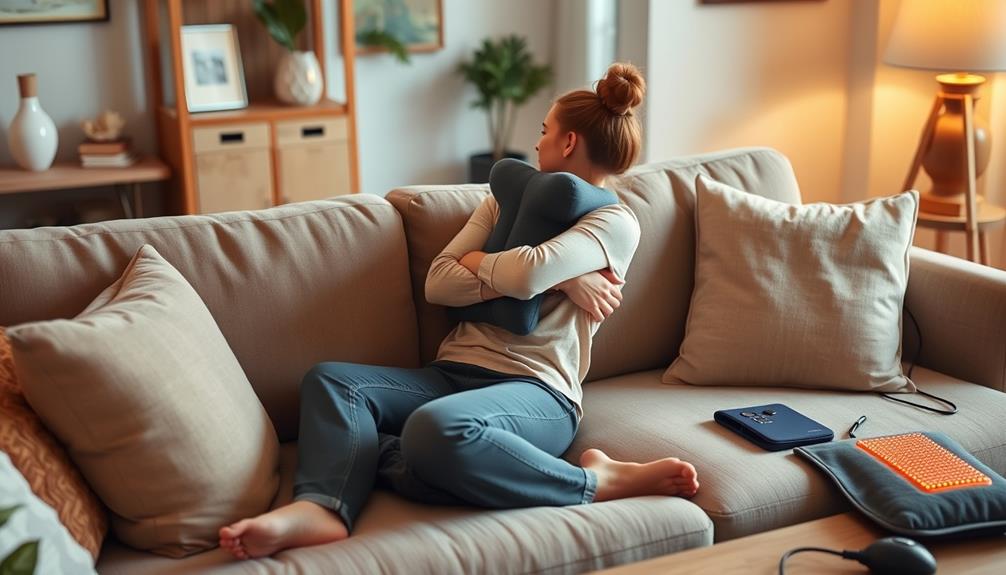
Sitting comfortably on a sofa can be challenging when sciatica symptoms flare up. To manage these symptoms effectively, guarantee your back is fully supported by the backrest. This support helps maintain proper spinal alignment, reducing pressure on the sciatic nerve.
Keep your feet flat on the floor; this position alleviates pressure on your hips and lower back, ultimately minimizing discomfort. Avoid crossing your legs while sitting, as this can increase pressure on the grounded leg, worsening your symptoms.
If you need extra support, consider using a lumbar support pillow or a rolled towel to help maintain the natural curve of your spine during prolonged sitting. This added support can make a significant difference in your comfort level.
Additionally, remember to regularly change your sitting position. Incorporating brief standing or stretching breaks can relieve tension and promote circulation, which is essential for managing sciatica symptoms.
When to Seek Help
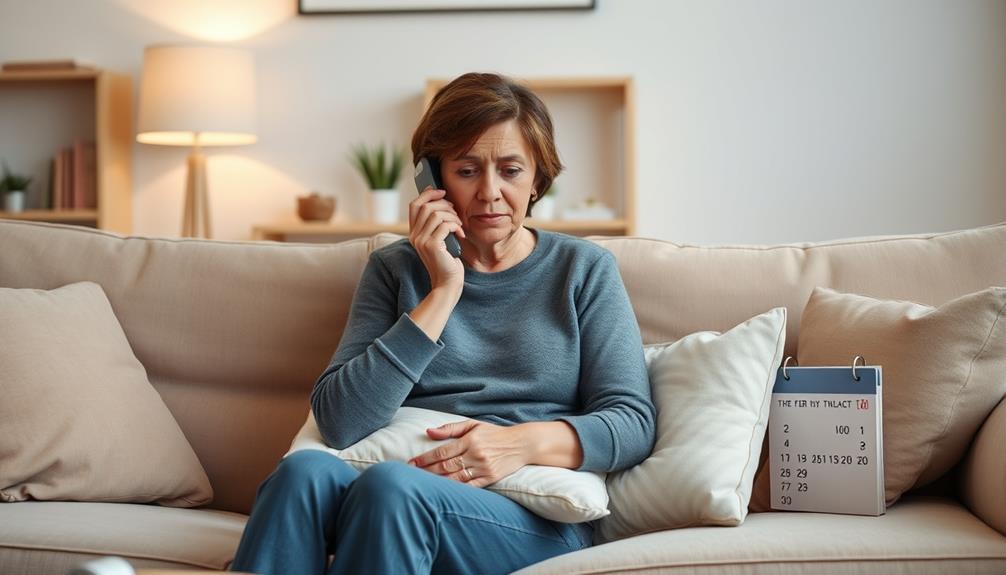
Recognizing when to seek help for lower back pain is essential for effective management and recovery. You should pay attention to your body and know when it's time to take action.
Here are three key instances when you should consider consulting a healthcare professional:
- Persistent Pain: If your lower back pain lasts more than a few days despite self-care measures, it's time to seek medical help for a thorough evaluation.
- Severe Symptoms: If you experience severe pain, numbness, or weakness in your legs, don't hesitate to seek immediate medical attention. These symptoms could indicate serious conditions like herniated discs or sciatica.
- Accompanying Issues: If your back pain comes with unexplained weight loss, fever, or changes in bowel or bladder function, it's vital to consult a healthcare professional promptly, as these may signal underlying health issues.
Regular check-ups with your healthcare provider can also help monitor your back health and prevent pain exacerbation related to poor sitting habits.
Staying proactive in addressing pain is key to your long-term well-being.
Additional Resources and Support
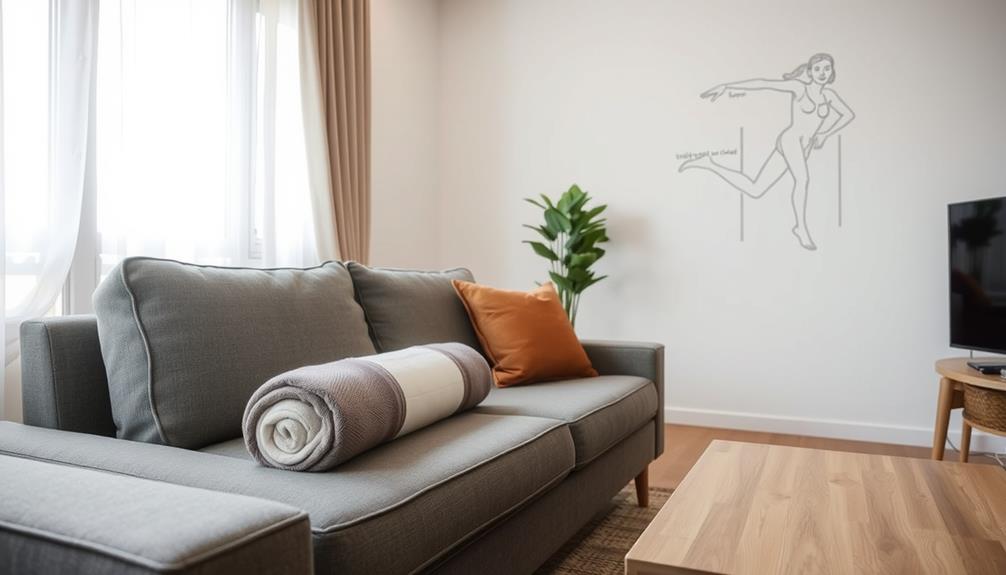
Finding effective support and resources can make a significant difference in managing lower back pain while sitting on a sofa. Consider incorporating ergonomic furniture, like lumbar support cushions and rise and recline chairs, to promote proper spinal alignment. These items help improve your posture and reduce pressure on your lower back, making your sitting experience more comfortable.
Regular consultations with healthcare providers or physical therapists can provide personalized strategies and exercises tailored to your needs. They can guide you in improving your posture and suggest stretches that fit into your routine.
Additionally, engaging in online communities focused on back health can offer valuable support, shared experiences, and practical solutions.
Don't underestimate the importance of movement breaks. Incorporating stretching and light exercises can help maintain your flexibility and reduce stiffness that comes with prolonged sitting.
To further enhance your sitting habits, consider using video analysis tools. They can help you self-assess your posture while sitting, allowing you to make adjustments that prevent discomfort and long-term back issues.
Frequently Asked Questions
How Should I Sit With Severe Lower Back Pain?
When you sit with severe lower back pain, use a cushion for support, keep your feet flat, and maintain a 90-degree angle with your knees. Remember to take breaks and stretch regularly to relieve tension.
What Is the Best Posture for Sitting on a Sofa?
Imagine a tree, roots firmly planted. For the best sofa posture, keep your feet flat, back supported, and knees at 90 degrees. Engage your core, and shift positions regularly to stay flexible and comfortable.
How to Sit in a Recliner With Lower Back Pain?
When you sit in a recliner with lower back pain, adjust the backrest for support, keep your feet flat, use lumbar support, engage your core, and shift positions regularly to reduce discomfort.
How to Sit on the Couch With a Herniated Disc?
When sitting on the couch, support your back, keep your feet flat, and avoid slouching. Position your hips higher than your knees, and remember to take breaks, stretch, and move to relieve tension.
Conclusion
Sitting on a sofa with lower back pain doesn't have to be uncomfortable. By understanding proper posture and making a few adjustments, you can find relief and enjoy your time sitting. Some might think it's too much effort to change habits, but the benefits of comfort and reduced pain are worth it. Remember, small changes can lead to significant improvements in your well-being. Prioritize your health, and don't hesitate to seek help when needed.
